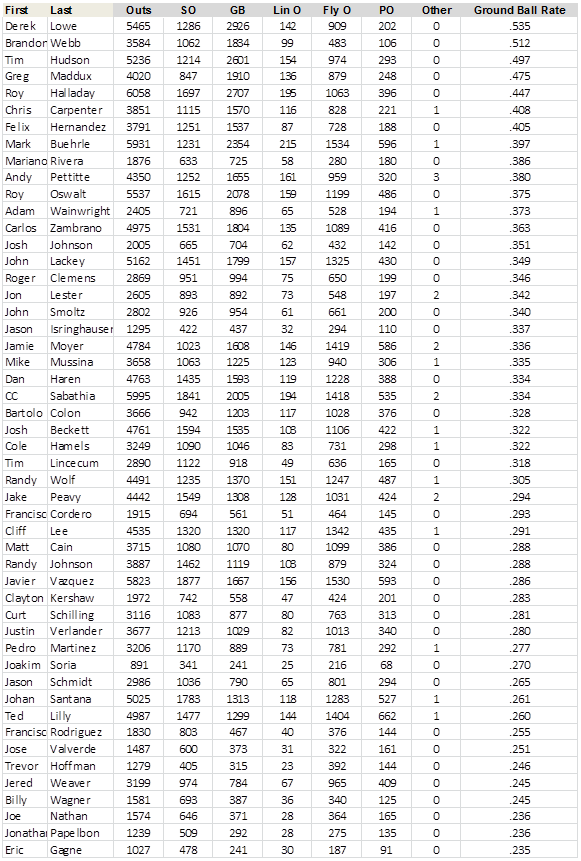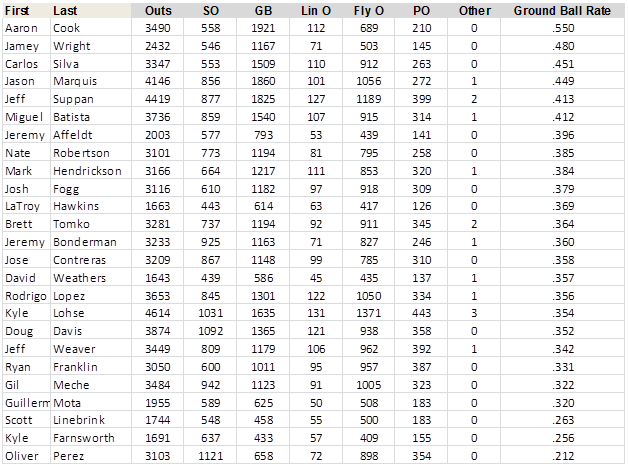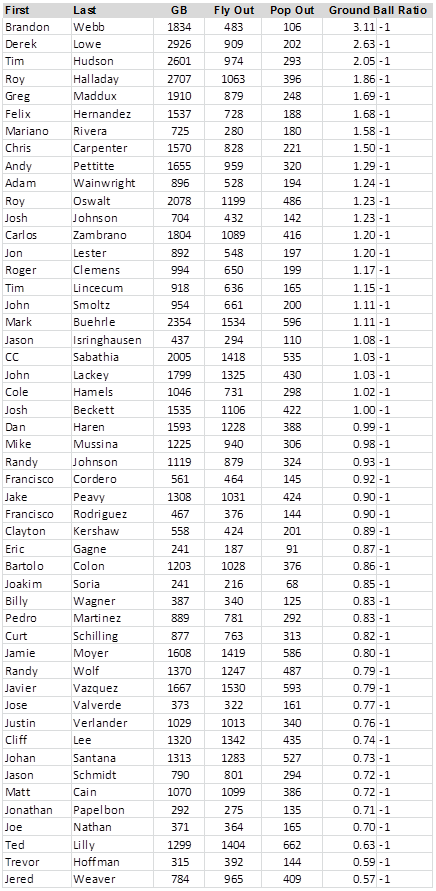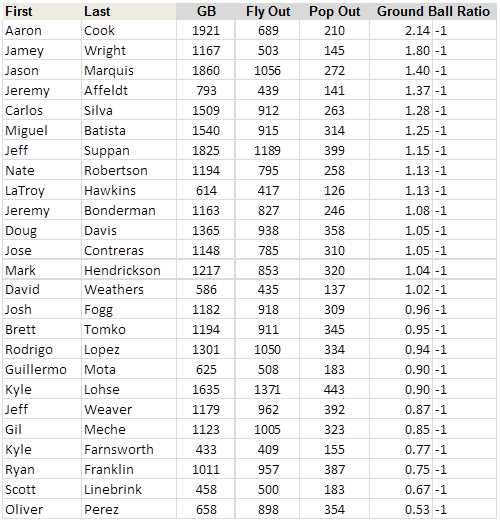There was a man who loved to fish, and one day he was so fortunate as to find an absolutely wonderful fishing hole. Some months later he was telling his friend about it. "It has everything you could possibly want in a fishing spot," he said. "It is cool and shaded. There is never anyone there. It has lots of food for the fish to eat, and underground shelter in which fish can live and breed. There is a brook that feeds into a deep pool at one end. It’s just perfect."
"Do you catch a lot of fish there?" asked his friend.
"Oh, no," replied the fisherman. "I’ve never actually caught a fish there. But I keep going back, because I’ve never seen such a perfect spot for fish to live in."
Ground Ball Pitchers
Another reason that SIERA is great at predicting ERA is that it accounts for the run-prevention effect of ground balls - particularly, it controls for the fact that the effect is nonlinear. Not only do more ground balls lead to fewer runs allowed, but the difference in ERA between pitchers who generate 40 to 50 percent ground balls is smaller than the difference in ERA between pitchers who generate 50 to 60 percent ground balls. That is why there is a negative coefficient on the squared ground-ball rate term in SIERA.
This data shows that ground-ball pitchers have a hidden value and that modeling BABIP indirectly as we did with SIERA, rather than assuming pitchers do not control it, helps improve the prediction of ERA. Statistics like xFIP have the benefit that the run value of defense-independent statistics (strikeouts, walks, and home runs) are done precisely with linear weights, but xFIP does not take into account that BABIP is lower for fly-ball pitchers. However, SIERA shows that extreme ground-ball pitchers also have a skill at preventing BABIP themselves.
Matt Swartz, Baseball Prospectus, December 15, 2010
What’s a ground-ball pitcher? And what’s so important about being one?
The first question is easy to answer; the second, less so. A ground-ball pitcher is a pitcher who is more likely to get opposing batsmen to hit groundouts than flyouts.
Why is it important? The thinking is that ground ball pitchers are less likely to give up big innings than fly-ball pitchers because it’s impossible to hit a home run with a ground ball.
Eric Brach, MLB.com, August 29, 2012
Usually, pitchers that get more outs from ground balls are more successful than pitchers who get more outs from fly balls.
Blue Compass Sports (Author unknown), dated 2013
General managers who rely upon sabermetrics as part of their decision-making process love pitchers with high ground ball percentages.
The feeling is that pitchers who make hitters pound the ball into the ground have a better chance of limiting big innings. That's because, at least in theory, the ground ballers should allow fewer home runs and induce more double plays.
John Perrotto, Covers
The Cleveland Indians traded a B prospect for a 38-year-old pitcher coming off a 5.05 ERA season, plus some cash. But by picking up Derek Lowe for the 2012 season, the Tribe have taken on a rare experiment: They're trotting out a collection of ground-ball pitchers that might be unrivaled in baseball history.
In adding Lowe to a rotation that also includes Justin Masterson and Fausto Carmona, the Indians will feature three of this year's top eight ground-ball-inducing starters. Throw in Ubaldo Jimenez and his above-average ground-ball rate and the Indians will field a staff unlike any other in the game. In a perennially weak division where little edges can mean a lot, the Indians may have found a new path to success, and just maybe a 2012 playoff berth.
To understand how extreme the Indians' staff figures to be, let's dive into some numbers. Lowe triggered grounders on 59 percent of the balls in play hit against him in 2011, Masterson 55.1 percent, and Carmona 54.8 percent. Over the past three seasons, Lowe, Masterson, and Carmona put up composite ground-ball rates of 58 percent, 56 percent, and 55 percent, respectively, three of the four highest marks in baseball. With apologies to some of the Tommy John-led staffs and other grounder-heavy rotations of the past, publicly available ground-ball data goes back just a decade. In that time, only five other teams have deployed three starters with GB rates of 50 percent or higher — four of them Cardinals staffs led by sinkerball fetishist/guru Dave Duncan. None had a higher aggregate ground-ball rate among its top three starters than what Lowe, Masterson, and Carmona put up this year. Jimenez's 47.2 percent GB rate was his lowest in any full season, but he's still above 50 percent for his career. The Indians' top four thus came in well above league-average ground-ball rates: 44.4 percent in 2011, 43.8 percent over the past 10 seasons.
So how does a team parlay a legion of ground-ballers into success? At its simplest level, the benefit of inducing a grounder is that it's much less likely to go for an extra-base hit and impossible to go for a homer.1 Pitchers who induce a lot of ground balls, without racking up many strikeouts, might be able to keep their pitch counts down, thus enabling them to go deeper into games and save their bullpens. Ground-ball pitchers can also be a relative bargain: Every team, the Indians included, would most prefer a pitcher who strikes out a ton of batters and doesn't walk many. But a staff full of Cliff Lees would wreck almost any team's budget. Find five Jake Westbrooks instead, and you might still see decent results at a fraction of the price.
Jonah Keri, Grantland, November 8, 2011
Look, it is easy to explain why Ground Ball pitchers should be effective pitchers.
The problem is, there are no fish there.
Allow me to rant for a few minutes here without any evidence. We’ll get to the evidence later; I’m just trying to frame the debate. Any analyst can give you a long list of reasons why ground ball pitchers should be the best pitchers. The problem is, they’re not.
Make a list of the best pitchers in baseball. Make a list of the best pitchers in baseball, in any era, and what you will find is that 80% of them are not ground ball pitchers. They’re fly ball pitchers. Tom Seaver was not a ground ball pitcher. Bob Gibson was not a ground ball pitcher. Randy Johnson was not a ground ball pitcher. Justin Verlander is not a ground ball pitcher. Pedro Martinez was not a ground ball pitcher. Roger Clemens was not a ground ball pitcher. David Cone was not a ground ball pitcher. Dwight Gooden was not a ground ball pitcher. Catfish Hunter was not a ground ball pitcher. Steve Carlton was not a ground ball pitcher.
Greg Maddux, of course, was a ground ball pitcher, and there have been a few others, like Kevin Brown. The vast majority of good pitchers are not ground ball pitchers, and the vast majority of ground ball pitchers are not good pitchers.
What I have never understood about ground ball pitchers, and do not understand now, is why they always get hurt. Show me an extreme ground ball pitcher, a guy with a terrific ground ball rate, and I’ll show you a guy who is going to be good for two years and then get hurt. I’m not saying this about Chien-Ming Wang and Brandon Webb; I was saying this before Chien-Ming Wang and Brandon Webb. They’re just the latest examples. Mark Fidrych. Randy Jones. Ross Grimsley. Mike Caldwell. Rick Langford. Lary Sorensen. Clyde Wright. Fritz Peterson. Dave Roberts. They’re great for two years, and then they blow up. Always.
Always? Well. ..Tommy John. If your defense argument here is a guy who is famous for having a surgery named after him, I’m not sure I’m convinced. Maddux and Glavine, sure, but neither Maddux was not an extreme ground ball pitcher until the last two or three years of his career. I don’t know whether Glavine was, or not.
Derek Lowe? Derek Lowe was sensational in 2002; the rest of his career he’s a .500 pitcher. You take Derek Lowe; I’ll take Verlander.
Look, I’m not really saying that there aren’t any good ground ball pitchers. What I am saying is that being a ground ball pitcher is not an advantage. It’s a disadvantage.
The 2012 Cleveland Indians loaded up on ground ball pitchers. How’d that work out? They finished 68-94 with a 4.79 ERA.
I posted a rant like this in August, 2010, to which Tango replied "does this mean that you would expect Adam Wainwright to not age as gracefully as other great pitchers?" Months later, Adam Wainwright had Tommy John surgery. He returned last year, went 14-13 with a league-average ERA.
Let’s go look at the evidence.
The Evidence
OK, it turns out that I am more wrong than right. I have this prejudice against Ground Ball pitchers, which I have had for a long time and I have written about before. It occurred to me that I should do a study to see whether the facts match up with my belief system.
My belief, simply stated, is that
1) All things considered, you are better off avoiding ground ball pitchers, and
2) Ground ball pitchers on the whole tend to be less successful than non-ground ball pitchers.
How do we test these propositions?
Here’s what I did. I formed two groups of pitchers, without any regard to their ground ball rates. The two groups of pitchers were
a) The 50 best pitchers in major league baseball in the years 2002 to 2011, which we will call the Gold Group, and
b) The 25 pitchers from the same years who best exemplified the idea of staying around in the majors, pitching a lot of innings without ever doing very much, who we will call the Blue Group.
My theory is that Blue Group will be significantly more dependent on ground balls than is the Gold Group.
How I formed the groups is not a critical issue; I am counting on it being self-evident that these are highly successful pitchers. First, these are the 50 pitchers that I identified as being the most successful pitchers in the major leagues in the years 2002 through 2011:
Josh Beckett
Mark Buehrle
Matt Cain
Chris Carpenter
Roger Clemens
Bartolo Colon
Francisco Cordero
Eric Gagne
Roy Halladay
Cole Hamels
Dan Haren
Felix Hernandez
Trevor Hoffman
Tim Hudson
Jason Isringhausen
Josh Johnson
Randy Johnson
Clayton Kershaw
John Lackey
Cliff Lee
Jon Lester
Ted Lilly
Tim Lincecum
Derek Lowe
Greg Maddux
Pedro Martinez
Jamie Moyer
Mike Mussina
Joe Nathan
Roy Oswalt
Jonathon Papelbon
Jake Peavy
Andy Pettitte
Mariano Rivera
Francisco Rodriguez
CC Sabathia
Johan Santana
Curt Schilling
Jason Schmidt
John Smoltz
Joakim Soria
Jose Valverde
Javier Vazquez
Justin Verlander
Billy Wagner
Adam Wainwright
Jered Weaver
Brandon Webb
Randy Wolf
Carlos Zambrano
The "Blue Group"—pitchers who were around a long time but never really did a whole lot—consisted of:
Jeremy Affeldt
Miguel Batista
Jeremy Bonderman
Jose Contreras
Aaron Cook
Doug Davis
Kyle Farnsworth
Josh Fogg
Ryan Franklin
LaTroy Hawkins
Mark Hendrickson
Scott Linebrink
Kyle Lohse
Rodrigo Lopez
Jason Marquis
Gil Meche
Guillermo Mota
Oliver Perez
Nate Robertson
Carlos Silva
Jeff Suppan
Bret Tomko
David Weathers
Jeff Weaver
Jamey Wright
The "Gold Group" pitchers—37 starters, 11 relievers and two pitchers who switched back and forth between bullpen and starting--accounted for 17 of the 20 Cy Young Awards in the years 2002 through 2011. The Blue Group—15 starters, 5 relievers and five pitchers who were used in both roles—pitched more seasons in the majors (per pitcher) than the Gold Group (9.32 to 8.26), but accounted for no Cy Young Awards.
It goes without saying that, if you set aside the "Gold Group" pitchers, you could not identify another group of 50 major league starters who had remotely comparable success in the years 2002 to 2011. It is equally true that if you set aside the Blue Group, you also could not find another, equal group of pitchers who hung around as long, pitched as much, and accomplished as little. This is how that group was defined.
The Gold Group pitchers made an average of 177 starts and 118 relief appearances in the ten years of the study. The Blue Group pitchers made an average of 150 starts and 208 relief appearances. The Gold Group pitchers had a winning percentage of .598, and an ERA of 3.47. The Blue Group pitchers had a winning percentage of .481, and an ERA of 4.51.
The Gold Group had 3,018 Saves in 5,920 relief appearances. The Blue Group had 347 Saves in 5,194 relief appearances.
Let’s look at the "out rates" of these two groups of pitchers.
Since 2002, Baseball Info Solutions has maintained charts of the outs recorded by each major league pitcher. Occasionally they miss a play because it isn’t broadcast anywhere, but they get something more than 99.5% of them. An out can be one of five things:
1) A strikeout,
2) A Ground Ball,
3) A Line Drive,
4) A Fly Ball,
5) A Pop Up, or
6) Other.
I am rather curious about what "other" entails. I have thought about this a lot, since it took me about 30 hours of research to do this damned study, and the only thing I have been able to come up with is
a) a batter stepping out of the batter’s box while hitting the pitch, or
b) some sort of interference call in which the ball is not put in play and there is no strikeout.
In more than 90,000 innings of pitching in this study there were a total of 36 "other" outs, or one for each 2,500 innings, so they’re not statistically significant, but I’d still like to know what they are.
Anyway, whether or not I am totally off base in my dislike of ground ball pitchers depends on how you look at the data. One way to look at it—and what I think is actually the best way to look at it—is to "rate" ground ball tendencies simply by the percentage of the pitcher’s outs that were by way of the ground ball. Roy Halladay in 2010 got out 700 hitters:
219 by strikeout
280 by ground ball
20 by line drive
139 by fly ball
42 by pop out
700 batters retired, 280 of them by ground ball; that’s a ground ball percentage of 40%. I think that’s the best way to look at it.
Looked at in that way, it is true that the Ground Ball Rates of mediocre pitchers are significantly higher than the Ground Ball Rates of good pitchers. (Conversely stated, the Ground Ball Rates of good pitchers are LOWER, not higher, than the Ground Ball Rates of mediocre pitchers.)
These are the Ground Ball Rates of the 50 best pitchers in major league baseball, 2002-2011, with Ground Ball Rates figured in this way:

These pitchers retired an average of 32.8% of hitters by Ground Balls, and only 6 of the 50 pitchers—12%--had Ground Ball rates over 40%.
These, on the other hand, are the Ground Ball Rates of the 25 pitchers in the Blue Group:

These pitchers recorded an average of 36.9% of their batter outs by way of the ground ball, and 6 of the 25—24%--were over 40%.
The reason the percentage is higher for the Blue Group than for the Gold Group, however, is simply strikeouts. We can also state the ground ball tendencies of the pitchers as a ground ball/fly ball ratio. If we do that, then the Ground Ball Ratios of the "Gold Group" are actually higher than the Ground Ball Ratios of the Blue Group:

While these are the Ground Ball Ratios of the Blue Group:

The Gold Group averages 1.095 to 1; the Blue Group, 1.080 to 1.
So what do we conclude? Well. ..I still don’t really like Ground Ball pitchers, but I do concede that I was, in the past, too radical in my distrust of them. I think that the advantages of throwing ground balls have been horribly overstated, and that the best way to get batters out is to find pitchers who can throw high fastballs. However, throwing ground balls does appear to be a small advantage for the pitcher, if you control for the number of strikeouts. Given two pitchers with the same strikeout rate and the same walk rate, it does appear that we should favor the one who gets more ground balls, although this advantage is probably no larger than the advantage of being a good fielder or the advantage of having a good move to first.
To clear up a couple of points:
a) When I talk about ground ball pitchers getting hurt, I’m not really talking about guys like Adam Wainwright and Andy Pettitte, with Ground Ball Rates around 38% or Ground Ball /Fly Ball Ratios around 5 to 4. In that context, I was talking about the guys with really extreme Ground Ball tendencies, like Chien-Ming Wang and Brandon Webb. Those guys, it seems to me, always self-destruct after a couple of years, unless their name is spelled "D-e-r-e-k-L-o-w-e". I don’t know why.
b) In the preamble ramble, I made the statement that 80% of the best pitchers are fly ball pitchers. That’s too extreme a statement; it doesn’t stand up to the evidence. We could say accurately that 80% of the best pitchers are not ground ball pitchers, defining a ground ball pitcher as "any pitcher with a ground ball/fly ball ratio of 3-2, or a ground ball out percentage above 40% or even very near 40%."
c) To say that "there are no fish there" is not accurate.
d) However, many of the statements which have been made by sabermetric advocates of ground ball pitchers are also inaccurate. But I will leave it for them to clean up their own messes.
Thanks for reading.